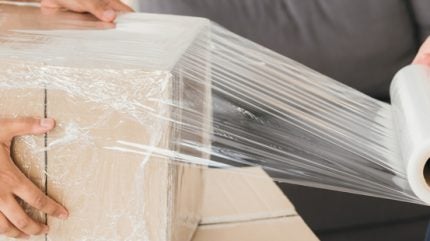
Shrink wrap and stretch wrap are two popular types of plastic films in the packaging industry, each with specific benefits tailored to different needs.
While both serve as protective coverings, they vary significantly in their application, materials, and protective properties.
This article will explore the distinctions between shrink and stretch wrap, focusing on their materials, uses, and pros and cons.
What Is shrink wrap?
Shrink wrap, also known as heat shrink wrap, is primarily used as a primary packaging solution applied directly to individual items. It consists of plastic film—typically made from polyolefin, polyethylene, or PVC—that wraps snugly around products when heat is applied.
The process involves covering a product with the shrink film, sealing it, and applying heat via a heat gun or tunnel. This causes the plastic to shrink tightly around the product, creating a firm, tamper-proof, and hygienic seal.
Shrink wrap is valued for its compact fit, which follows the product’s shape, offering excellent protection and visual appeal.
It’s often seen on consumer items such as DVDs, books, food products, and electronics, making it easy for consumers to view the product without handling it directly. Larger items, such as boats or machinery, can also benefit from shrink wrap due to its durability.
Advantages of shrink wrap
- Compact and secure: The shrink film’s snug fit reduces excess packaging, saving storage space and improving product stability.
- Durable and tamper-evident: The process of shrinking increases the film’s strength, providing a tamper-resistant seal.
- Transparent: The clear film allows products to remain visible, making it ideal for retail packaging.
- Protection from moisture and dust: Creates an air-tight seal, keeping items clean and dry.
Disadvantages of shrink wrap
- Specialised equipment needed: Applying shrink wrap effectively requires heat-sealing equipment, such as a heat gun or tunnel, and a sealer.
- Odour and emissions: Certain types of shrink films, like PVC, can release odours and fumes when heated.
- Higher material costs: Shrink wrap film can be pricier than other wrapping options, particularly when considering high-volume applications.
What Is stretch wrap?
Stretch wrap is a secondary packaging solution widely used for bundling products together, commonly applied to pallets for easy transport and storage. Unlike shrink wrap, stretch wrap doesn’t require heat.
Instead, it relies on tension and elasticity, applied by hand or machine, to secure items tightly. Stretch wrap is primarily composed of low-density polyethylene (LLDPE), a highly flexible material that provides a robust layer of protection.
Stretch wrap is most effective for stabilising larger loads, such as boxes or products grouped on pallets. This wrapping method safeguards items against damage and environmental factors during shipping or storage.
It can be applied manually for smaller projects, or with an automatic stretch-wrap machine for high-volume operations.
Advantages of stretch wrap
- Cost-effective: Stretch wrap is generally cheaper than shrink wrap and is also easy to use with minimal equipment.
- Durable and water-resistant: The tough, tear-resistant film offers a secure layer of protection against environmental elements like moisture and dust.
- Flexible application: Can be applied manually or with a stretch-wrapping machine, making it suitable for a range of packaging needs.
- Efficient for bulk packaging: Ideal for bundling multiple items, ensuring stability and ease of transport.
Disadvantages of stretch wrap
- Equipment for high-volume needs: For larger packaging operations, specialised equipment such as pallet turntables or wrapping machines is necessary to speed up the process.
- Limited aesthetic appeal: Unlike shrink wrap, stretch wrap is typically used for bulk or secondary packaging, so aesthetic appeal is less of a priority.
Choosing the right wrap for your needs
When deciding between shrink and stretch wrap, understanding their distinct applications and benefits can help determine which option suits your packaging needs best.
Shrink wrap for individual products Shrink wrap is ideal for individual product packaging where a protective, tamper-evident seal is essential. Commonly used in consumer goods, shrink wrap offers the added advantage of preserving freshness and visibility.
Its durability also makes it a preferred choice for products that need secure, direct packaging for retail.
For businesses managing large-scale packaging of smaller items, investing in shrink-wrapping equipment, such as heat sealers and tunnels, can enhance efficiency. This method ensures that items reach consumers in pristine condition, protected from contamination and damage.
Stretch wrap for bulk shipments Stretch wrap shines in scenarios requiring bulk packaging and pallet stabilisation. Its cost-effectiveness, ease of application, and ability to protect goods during transport make it a go-to choice for businesses managing high-volume shipments.
Stretch wrap’s water-resistance and flexibility in securely bundling various shapes make it invaluable for pallets of stacked boxes or awkwardly shaped items.
For companies with high turnover in bulk shipments, automated stretch-wrapping machines provide a time-saving advantage. These machines streamline the process, enabling a more uniform application while minimising material waste.
Final considerations. Ultimately, shrink wrap and stretch wrap each provide unique advantages and are best suited to specific packaging requirements.
Shrink wrap offers a compact, durable, and tamper-evident packaging solution ideal for retail items, while stretch wrap serves as a cost-effective, reliable choice for bundling and protecting items during transit.
By considering the needs of the products, packaging volume, and environmental factors, businesses can select the most appropriate wrap to ensure product safety and optimise their logistics.



